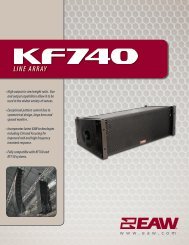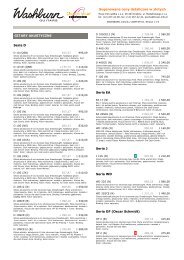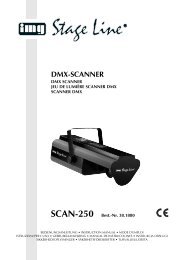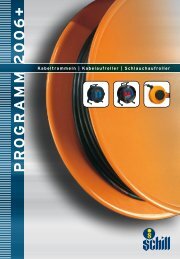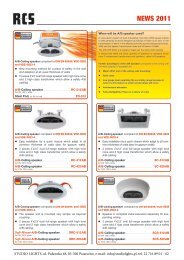Part - Studio Lights
Part - Studio Lights
Part - Studio Lights
You also want an ePaper? Increase the reach of your titles
YUMPU automatically turns print PDFs into web optimized ePapers that Google loves.
KNOW-HOW OF THE 100V PA TECHNOLOGY<br />
LOUDSPEAKERS<br />
It is not possible within the limits of these “tips and clues for<br />
100V PA technology” to present all relevant information and<br />
explanations.<br />
However, we may illustrate and make understandable many<br />
important points and problems occurring with the installation of<br />
100V PA systems.<br />
*<br />
1.) Arrangement of speakers<br />
When planning a PA system, it is the main aim to achieve a consistent<br />
acoustic irradiation and understandability within the<br />
room or area to be provided.<br />
The loudspeakers should be installed in equal intervals in order<br />
to avoid areas with unpleasantly high loudness. Most of the<br />
commonly used cone speakers show an angle of beam spread<br />
of 90° at the -6 dB points in the medium frequency range.<br />
Taking this fact into consideration, the loudspeakers can be<br />
arranged in such a way that the listener will always stay in the<br />
range of at least one speaker.<br />
As far as outdoor systems are concerned, sometimes<br />
neighbouring areas are also irradiated acoustically, which is<br />
often felt as an annoyance. By using reflex horn speakers and<br />
their accurate positioning and orientation, such disturbances<br />
can be avoided or at least minimized.<br />
Horn speakers usually radiate within an angle of 30° in the medium<br />
frequency range, whereby it is possible to obtain the wanted<br />
directivity.<br />
*<br />
2.) Nominal load capacity<br />
The nominal load capacity of a loudspeaker is the power a<br />
speaker can carry without noticeable distortions or damage to<br />
the system.<br />
The power output of a loudspeaker (in W) is only conditionally<br />
suited for judging its achievable volume, the more so as in many<br />
cases - caused by the “power and watts mania” in consumer<br />
electronics - partly unreliable work is done.<br />
Thus, the indication of the sound pressure in dB at 1W/1m is<br />
much more honest and meaningful, especially if also the loudspeaker´s<br />
frequency range is incorporated in the judgment of its<br />
quality. However, here the adjustment of the single parameters<br />
is very important, too, as e.g. a very high sound pressure alone<br />
does not reveal very much.<br />
*<br />
3.) Sound pressure<br />
Sound pressure is typically specified in –dB at 1 kHz and for a<br />
power supply of 1 W at 1m distance from the sound source.<br />
Exact information on a speaker system´s quality can only be<br />
given by means of a measuring diagram (course of the sound<br />
pressure over the complete frequency range).<br />
By the way, the sound pressure of 100V loudspeakers normally<br />
is considerably higher than of Hi-Fi loudspeakers:<br />
Hi-Fi loudspeaker ca. 85-90 –dB at 1W/1m<br />
100V loudspeaker ca. 90-100 –dB at 1W/1m.<br />
*<br />
4.) The 100V PA technology<br />
As already mentioned, loudspeakers with so-called 100V sound<br />
output transformers are normally being used with 100V PA technology.<br />
The output of the amplifier is increased within its sound<br />
output transformer to a nominal voltage of 100V.<br />
This 100V AF signal is then distributed through the line network<br />
to the single loudspeakers. Next, the sound output transformer<br />
within the loudspeaker lowers this AF signal to an appropriate<br />
voltage, so that the connected speaker is provided exactly with<br />
its designated nominal rating and impedance.<br />
Big advantages of the 100V PA technology are among other<br />
things:<br />
a) Smooth switching on of the loudspeakers:<br />
100V loudspeakers are simply connected in parallel, regardless<br />
of their power input and impedance. However, the total<br />
power of all connected loudspeakers must not exceed the<br />
nominal rating of the corresponding amplifier. Otherwise the<br />
amplifier will be out of order after a while.<br />
b) Bigger circuit lengths possible:<br />
Because of the higher voltage transmitted with 100V PA<br />
technology (compared to the low impedance technology<br />
used in consumer electronics), the losses within the line network<br />
are comparatively small.<br />
The 100V PA technology makes it possible to run very long<br />
lines, even with a comparatively small wire diameter, e.g. 2 x<br />
0.75 mm.<br />
c) Small wire diameter sufficient:<br />
With 100V technology, less power is lost in the line network<br />
than usually with the conventional architecture of consumer<br />
electronics or even “professional sound”. Therefore, a smaller<br />
wire diameter is sufficient even for demanding 100V PA<br />
installations.<br />
Normally cable types IYSt 2 x 0.75 or similar are used. As the<br />
case arises, details should be discussed with an expert.<br />
However, it can be said basically that speaker line lengths of<br />
500m and more are trouble-free for 100V technology.<br />
*<br />
5.) Crosstalk effect<br />
If several speaker lines are carried by one single cable, the danger<br />
arises that the signal of one line is transferred capacitively to<br />
another.<br />
It may occur by this means, that a loudspeaker, not at all<br />
addressed, suddenly and quietly transfers an external calling<br />
signal. As far as systems with several programs are concerned,<br />
even different programs may be transmitted to the same speaker.<br />
As this effect depends on the cable type used, as well as on the<br />
line´s length and on the supplied power, a solution of the problem<br />
should be discussed with an expert.<br />
Please note: For each signal, one pair of wires, belonging together<br />
and stranded with each other, should be used.<br />
*<br />
6.) Wall and ceiling built-in loudspeakers<br />
These types of loudspeakers are well-suited for a local acoustic<br />
irradiation of large sales areas, halls, etc., but also for smaller<br />
rooms.<br />
They are available in many different models, e.g. for flush-mounting<br />
and surface mounting, round, oblong, square, with a pervious<br />
grille, made of plastic, full metal, etc.<br />
The load rating of wall and ceiling built-in loudspeakers normally<br />
ranges between 6 and 20 W.<br />
*<br />
7.) Column speakers<br />
These are usually applied in larger rooms, whereas several<br />
column speakers are combined and hung up in the middle of a<br />
300



